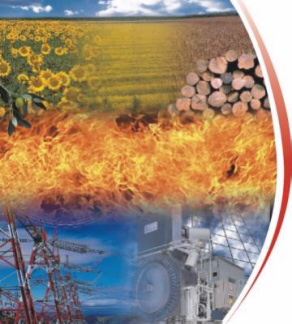|
What is hydroelectricity?
Hydroelectricity is electricity derived from water power, which is derived from solar energy. (Water gains potential energy
as it is deposited at high elevations (precipitation) during the hydrologic cycle, which is driven by solar energy.) Hydroelectricity
is most commonly generated by dams, which convert the potential energy of water from a river into kinetic energy to turn turbines.
A dam is a wall of concrete that blocks the flow of a river, creating a reservoir. Water from the river flows down a narrow
channel (the penstock) and turns a turbine, which generates electricity.

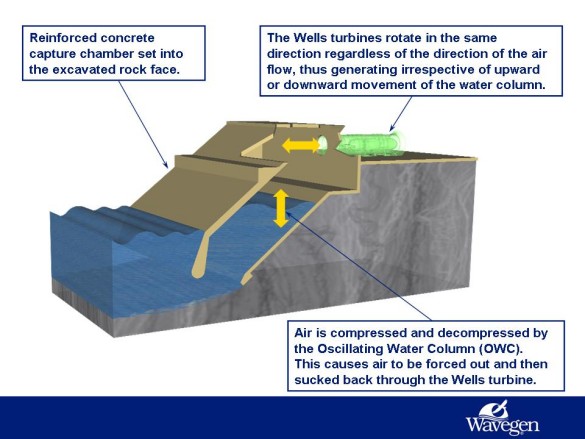
|
| Wave power station |
Dams are not always necessary to generate power from flowing water, as in the case of micro-hydro power, also known as small
scale hydropower, which generates no more than 10 MW of electricity. Small hydro projects vary in design, and are used in
remote areas where other forms of energy are not widely available.
Electricity can also be generated from tides using two different systems. Tidal stream systems (analogous to windmills)
use the kinetic energy from currents to turn turbines; barrages (analogous to dams) are similar to dams in that they use the
potential energy derived from the difference in water level between high and low tides.
Energy can also be generated from surface ocean currents. A wave power station is a hollow box that is half-submerged
to catch waves. Entering waves push air through a vent, causing a turbine to spin. The turbine spins again as air is drawn
out by the receding wave.
Hydropower in Norway:
Norway, the largest producer of hydroelectric power in Europe, and the sixth largest producer of hydroelectric power in the
world, produces about 5% of the hydroelectric power in the world. Hydropower accounts for 99% of the electricity produced
in Norway. Norway currently has 850 hydroelectric power plants.
Geothermal Energy:
What is geothermal energy?
Geothermal energy is the natural heat in the earth, derived from heat within the Earth's core, friction from tectonic plate
movement, and radioactive decay. Groundwater near volcanoes is heated naturally, and rises until trapped by an impermeable
layer in the Earth's crust, forming a hydrothermal reservoir, which can be tapped to supply heat or generate electricity.

|
| Geothermal power plant above hydrothermal reservoir |
Individual homes and buildings can use geothermal energy directly by installing geothermal heat pumps, which use the temperature
difference between the Earth's surface and subsurface to heat and cool buildings.
There are three main types of geothremal power plants: dry steam, flash steam, and binary cycle.

Dry steam plants use mainly steam to turn turbines. The world's largest geothermic power plant, The Geysers, uses this technology.
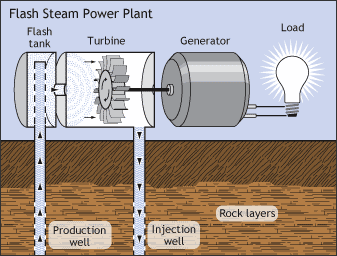
Flash steam plants are driven by hydrothermic fluids above 360 degrees Fahrenheit, which enter a chamber held at much lower
pressure than the fluid. This causes the fluid to "flash", or vaporize; the resulting steam is used to turn a turbine
that generates electricity.
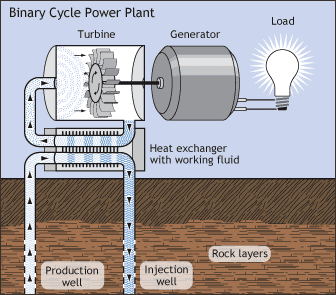
Binary-cycle powers plants use two different fluids. Hydrothermic fluids that are moderate in temperature pass through a tube,
where it meets a second fluid (which has a lower boiling point) in a heat exchanger. The second fluid flashes and drives the
turbine. It then condenses and passes through the heat exchanger again.
Geothermic Energy in Iceland:
The Mid-Atlantic Ridge runs through Iceland; because of this, the country has a high concentration of volcanoes. Geothermal
energy generates heat and electricity in two-thirds of the homes in Iceland, and is used to heat the greenhouses where most
produce is grown. Five geothermal plants produce 26% of the nation's electricity. 87% of Iceland's homes are heated with geothermal
heat pumps. The Svartsengi Power-Plant and Nesjavellir Power-Plant produce electricity, and the Krafla, Reykjanes, Hellisheiği
power plants produce both electricity and hot water. Geothermal energy is so widely available that it is used to heat pavement
(to melt snow).
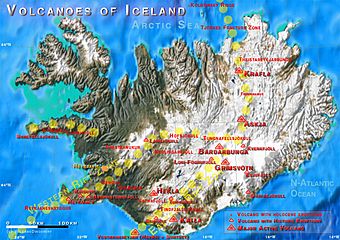
|
| The Mid-Atlantic Ridge runs through Iceland, causing it to be geologically active. |

Ethanol:
What is ethanol?
Brazil's Ethanol Program:
In 1973, OPEC placed an embargo on oil to punish nations supporting Israel in the war against Egypt and Syria. In response,
Brazil started the 1975 Pro-Alcool (National Alcohol Program), intended to phase out fossil-fuel run automobiles and replace
them with ones that ran on a mixture of ethanol (24%) and gasoline (76%), also known as "gasohol". Ethanol was manufactured
from bargasse, the fibrous material in sugar canes, which were relatively cheap and easy to grow in the tropics, and an efficient
ethanol source. Even so, the program required a tremendous amount of cooperation. Government subsidies helped to start the
program by encouraging sugar canes to be planted, distilleries to be constructed, and automobiles to be designed and manufactured.
Currently, all of the newer designed cars are able to run on gasohol or can flexibly run on both pure gasoline and gasohol.
The success of Pro-Alcool has made Brazil one of the top ethanol-producing countries in the world.
|
